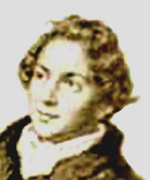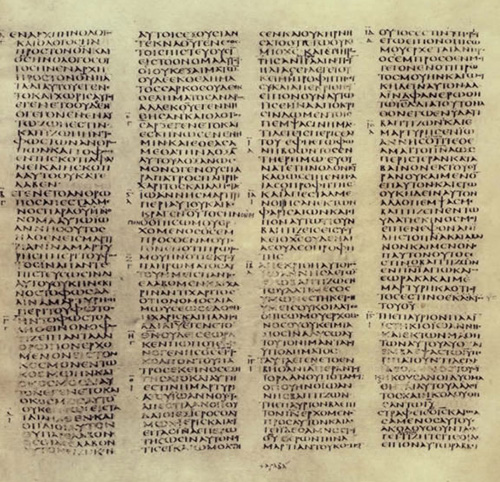Gallery of Philologists
Constantin Tischendorf
18 Jan 1815 (Langenfeld, Saxony) - 7 Dec 1874 (Leipzig)
Blessed are they who find a purpose in life, doubly blessed are they who find it early, and trebly blessed are they who have the stamina to see it through. Lobegott Friedrich Constantin von Tischendorf found it early. While studying theology at Leipzig, 1834-1838, he was moved by his teacher Johann Winer (who in 1822 had written the standard grammar of Greek) to take on what in a letter to his fiancée he called a "sacred task: the struggle to regain the original form of the New Testament." In 1838 he received his degree, with a thesis on the sources for the New Testament; in October 1840, supported by the government of Saxony, he began the laborious task of deciphering the palimpsest codex Ephraemi and several other manuscripts at the Bibliothèque Nationale in Paris; with time out for exploratory visits to England and the Netherlands, this occupied him until January 1843. During those years he issued a preliminary new edition of the New Testament, making use of Lachmann's very recent results. All this was to be only the beginning of his searches for more and better manuscript sources for the New Testament.
It was not all Sitzfleisch; there were also exciting moments. In 1844, Tischendorf, by then nominally a Privatdozent at Leipzig (his reading of the overwritten Biblical text of the Ephraemi manuscript, previously thought irrecoverable, had won him considerable renown), but in fact out in the field and looking for evidence, visited the monastery of St Catherine on Mt Sinai. In a wastebasket of discarded papers to be used as fuel for the monastery oven, he happened to find forty-three leaves of what he recognized (there is something to be said, in this business, for educating one's powers of recognition) as a copy of the Septuagint version of the Old Testament, written in early Greek script. The monk in charge cheerfully informed him that two basketloads of such discarded leaves had already been fed to the oven. He was later able to view the codex from which they had been taken, and warned the monks that these pages were too valuable to be used for fuel. He was allowed to keep his forty-three discarded leaves, and they were eventually deposited in the library at Leipzig. They contain parts of 1 Chronicles, Jeremiah, Nehemiah, and Esther. He married in 1845, and began to publish an account of his travels in the East (1845-1846). In 1846, Tischendorf published the contents of his St Catherine find, though without revealing the source of the manuscript.
On returning to that monastery in 1853, Tischendorf found the monks more cagey, and could learn nothing further.
In 1859, now working under the patronage of Czar Alexander II of Russia, he went again to St Catherine's. The day before his departure from the monastery, he presented the steward with a copy of the Septuagint which he had previously published in Leipzig. The steward said, Very nice, but he too had a copy of the Septuagint. He forthwith produced from a closet in his cell a manuscript wrapped in red cloth. Wisely concealing his excitement, Tischendorf asked to look at it that evening. He stayed up all night (as he remarked to his diary in Latin, Quippe dormire nefas videbatur - "It really seemed a crime to sleep." Indeed. For not only was the Old Testament (the complete Septuagint) present, but also the entire New Testament, in excellent condition, and containing as well two noncanonical writings, the Epistle of Barnabas (previously known to scholarship only from a poor Latin translation) and most of the Shepherd of Hermas (previously known only by title).
Next morning, Tischendorf offered to buy the manuscript. This was refused. He asked to be allowed to take it with him to Cairo to study it. This too was refused. Tischendorf departed without it. But in Cairo, there was another small monastery of the monks of St Catherine. The abbot was then in Cairo. Tischendorf begged him to send for the manuscript. It was delivered, but only quire by quire (eight leaves at a time) for Tischendorf to copy. Two Germans in Cairo who also knew some Greek were enlisted to help with the transcription, and Tischendorf carefully revised their work. In two months they had transcribed the 110,000 lines of the text. It then transpired that the position of highest authority among the monks of Sinai was vacant. Tischendorf suggested that it would be to the monks' advantage, in the election of a new abbot, if they would make a gift to the Protector of the Greek Church, who happened to be Czar Alexander II of Russia. No gift, surely, would be more appropriate than this Sinai manuscript. After extended negotiations, the manuscript was given to Tischendorf to publish at Leipzig, and then to present to the Czar on behalf of the monks. The Czar sent the monastery a silver shrine for St Catherine, 7,000 rubles for the library at Sinai, and 2,000 rubles for the monks at Cairo, along with conferring Russian honorary titles on the monastery authorities. In 1863 the manuscript was published in Leipzig at the Czar's expense, from Tischendorf's meticulously accurate transcript, and preceded by his no less meticulous annotations.
Such, and more of like kind, is the heroic part. But Tischendorf was not only an intrepid explorer and an indefatigable transcriber. He also understood what to do with the transcription. Codex Sinaiticus immediately took its place as one of the best and oldest manuscripts of the New Testament. So did the invaluable Codex Vaticanus, which also Tischendorf was the first to make available to scholarship. Then began the task of comparing the readings of these invaluable manuscripts against others, and arriving at the reading which most probably represents the archetype: the text from which both manuscripts are ultimately descended. How does one make those decisions? Tischendorf throughout his career issued texts of the New Testament embodying his best conclusions, and in one of them (1849), his principles of text criticism were articulated in this way (as summarized from Epp):
1. Readings peculiar to one witness are suspect.
2. Manifest scribal errors, however widely attested, are to be rejected.
3. Readings with OT or NT parallels are suspect as contaminated.
4. More probable than others is the reading that appears to have occasioned the others. "Taken broadly, says Tischendorf, this is the foundation of all rules."
5. Readings are preferable which are in accord with authorial style.Rule 4, as Tischendorf seems to have realized, is the heart of the whole business. It is also the heart of everything else in philology, including the determination of the direction of indebtedness between parallel passages in two or more different texts. That extension was not made by Tischendorf, and it is the sense of the NT field that he should not be held accountable for it. That step has therefore been credited to the undersigned. But all honor to the one who, even if he did not appreciate its full extent, first saw the point which underlies all good philological judgement, both before and after his own time.
In 1869, Tischendorf was made a Russian noble by the Czar, hence the "von" in his name.
Tischendorf was not utterly focused; he corresponded with his fellow German Romantic Robert Schumann, and Felix Mendelssohn once dedicated a song to him. But his tremendous energy and single-minded application ultimately took their toll of his merely human frame. In 1869-1872 he published the two volumes of the eighth and last of his editions of the New Testament. On 5 May 1873, he suffered a stroke from which he never fully recovered. He died on 7 December 1874 in Leipzig. In his will, he said of his life:
"Gott hat mir ein glückliches, von seinem Segen reich geschmücktes Leben geschenkt. Mühe und Arbeit ist’s gewesen, aber sie war mir in Wahrheit köstlich. Lege Gott seinen Segen auch auf das, was ich der Nachwelt hinterlasse … es ist Sein Werk."
He had indeed left much behind - the two best manuscripts of the Bible, editions incorporating their evidence into a purified text of the Bible itself, and the soul of the principles whereby scholars may move with some confidence from the manuscript resources to the archetype Scriptures. Further progress there would be, but on the basis, and with the conceptual tools, left by Tischendorf.
His labors, arduous yet precious to him, bore fruit, and his final prayer was handsomely answered.
A facsimile publication of Codex Sinaiticus came later, in 1911, and another in 1922. In 1933, the British government was able to purchase the manuscript of Sinaiticus from the then no longer interested Soviet government at a cost of one hundred thousand pounds sterling. It was escorted to the British Museum with great public ceremony, and as of this writing, it still resides there. Tischendorf's personal library eventually came to the University of Glasgow; the Scottish NT text critic Matthew Black collaborated in a monograph on him and his work which was published from that University's Press in 1981.
Readings
- Novum Testamentum Sinaiticum sive Novum Testamantum cum Epistula Barnabae et Fragmentis Pastoris / ex Codice Sinaitico Auspiciis Alexandri II Omnium Russiarum Imperatoris ex Tenebris Protracto Orbique Litterarum Tradito Accurate Descriptit Aenotheus Fridericus Constantinus Tischendorf. Lipsiae: F A Brockhaus 1863.
- Novum Testamentum Vaticanum post Angeli Maii Aliorumque Imperfectos Labores / ex Ipso Codice Edidit Aenoth. Frid. Constant. Tischendorf. Lipsiae / Giesecke et Devrient MDCCCLXVII.
- Matthew Black and Robert Davidson. Constantin von Tischendorf and the Greek New Testament. Glasgow 1981
21 Feb 2007 / Contact The Project / Exit to Gallery Index Page

